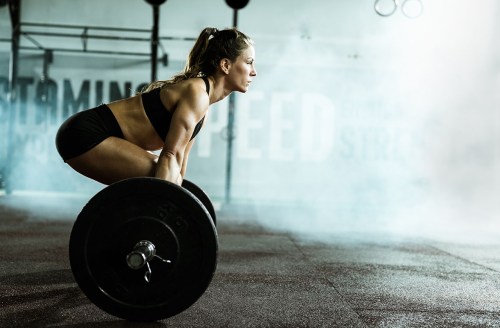“Deadlifts are the ultimate total body exercise,” says Brianna Bernard, CPT, Isopure Athlete and Certified Personal Trainer. When performed with the correct form, deadlifts work your lower back, lats, core, glutes, quads, hamstrings, and even help improve your posture and grip strength. On top of that, when you are doing higher repetitions of the exercise, you can turn this strength move into a cardiovascular workout by elevating your heart rate.
Experts in This Article
a certified personal trainer, nutrition coach, and mindset mentor
That being said, with so many variations of the move—from single-leg to Romanian deadlifts—as well as form cues to follow, it can be challenging to know where to start. Scroll down to learn everything you need to know about how to do a deadlift the right way, according to a top personal trainer. And a word to the wise: If you are just starting out, don’t feel intimidated by being a beginner in a gym filled with pro-looking lifters. Finessing your deadlift form is one of the best things you can do to get stronger (and we promise that no one’s watching).
How to do a deadlift correctly and safely, according to a Certified Personal Trainer
1. Start light
When it comes to the common mistakes Bernard notices when people are first learning how to do a deadlift, many of the struggles can be solved with one quick change: Grab a lighter bar. “Start with a light bar and some ten pound bumper plates and focus on your form first. Once you’ve worked on form and practiced, then you can slowly increase the weight while maintaining proper alignment to reap the full benefits of the move,” explains Bernard. Starting light is key for both efficacy and safety when deadlifting.
2. Put on a lifting belt
Bernard also suggests wearing a lifting belt to help support your lower back. “The tightness of the belt will be a good reminder to keep your back straight and your core tight.”
3. Check your alignment before you lift
When preparing to lift, it is very important to ensure that you are in the proper position. Stand with your feet shoulder-width apart, line your shins up to the barbell, bend your knees so that your hamstrings are parallel to the floor, and grip onto the barbell just outside your legs. You can choose to use either a double overhand grip or a hook grip—with your dominant hand overhand and your non-dominant hand underhand—based upon what makes your body feel more stable, strong, and comfortable. Generally speaking, the double overhand works best for beginners; the hook-style grip is for more advanced deadlifters, as it will allow you to lift heavier weight. If you choose to go the hook grip route, make sure to switch your hands regularly to prevent any muscular imbalances from developing.
4. Look straight ahead to keep your spine and neck neutral
“A lot of people look up when they deadlift,” says Bernard. Though it seems logical to try to look at yourself in the mirror, this encourages you to arch your spine and your neck, which puts you at risk of injury. In order to be your strongest, it’s important to maintain a neutral spine and flat back, which means either looking straight ahead or even looking down on occasion. Just make sure to avoid tucking your chin.
5. Pull your shoulders back, too
If the temptation to drop your shoulders and arch your back is overwhelming, it could mean that your weight is too heavy and can result in many lower back injuries. It’s key to keep your shoulders pulled back, chest up, and lats engaged to prevent them from rounding forward. Also, hold the barbell as close to your body as possible and keep it over the center of your feet. If the barbell is not close to your body, it is going to feel heavier and you are at a higher risk of injury, explains Bernard.
6. Lock your elbows as you lift
Make sure that there is no slack or bend in your elbows. If your elbows are locked out, you will be able to “simultaneously pull the bar up your shins and push the floor away with your feet,” says Bernard. Squeeze the bar as tight as you can before it leaves the floor. “Continue pulling until you are standing up tall with your knees locked out, then slowly hinge at the hips and lower the barbell back toward the floor as close to your body as possible, bending your knees once the barbell is safely below them and you return to the starting position.”
7. Breathe and engage your core
This seems obvious, but remember to breathe. “Take a deep breath and hold it prior to pulling the barbell away from the ground. On your way up, exhale, and before lowering the barbell back down to the ground, you should take another deep breath and hold it as you go back to the starting position. This core engagement will help protect your lower back from injury,” explains Bernard.
8. Do “accessory lifts”
According to Bernard, adding barbell back squats, barbell high hip deadlifts, barbell hip thrusts, barbell bent over rows, and back hyperextensions to your lifting routine will help balance out your muscles and prevent overuse, strain, or fatigue as well as help to increase your overall strength and improve form.
Check out the video below to learn the right way to do a single-leg deadlift from top trainer, Charlee Atkins:
Oh hi! You look like someone who loves free workouts, discounts for cult-fave wellness brands, and exclusive Well+Good content. Sign up for Well+, our online community of wellness insiders, and unlock your rewards instantly.
Sign Up for Our Daily Newsletter
Get all the latest in wellness, trends, food, fitness, beauty, and more delivered right to your inbox.
Got it, you've been added to our email list.











